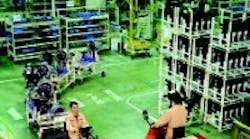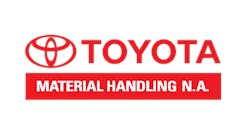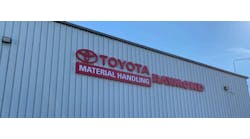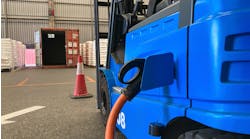For almost 10 years the Whirlpool Corp. plant in Marion, Ohio, has been delivering parts on an hourly basis to its assembly lines using carts and tuggers. In April of last year they started installing a brand new line from the ground up. It was an opportunity to try something new.
"Today on our traditional main assembly lines we only bring out small boxes of purchased parts, like screws, nuts and bolts, and small plastic parts [by tugger]," says Bill Condon, lead materials engineer at the Marion Division. Dryer manufacturing is currently being consolidated into this factory following Whirlpool's (Benton Harbor, Mich.) purchase of Maytag.
"Any purchased part that wasn't a skid, we would pick it from a supermarket and deliver it to the assembly line by kanban," he says. Parts supermarkets (temporary storage areas with preset inventory levels) and kanban (a signaling device, often a card or container, that triggers part replenishment) are lean manufacturing techniques. Large parts and packaging material received on pallets are all moved to these traditional assembly lines by lift truck.
The new line produces a high-end Kenmore brand product for Sears. Following the example of some automotive factories, it maximizes the use of tuggers to feed parts to the line, taking advantage of "right-sized" packaging and some clever carts to remove lift trucks from the lineside material delivery process altogether.
Right-sized packaging means that parts received from suppliers arrive at the plant divided into more manageable increments. Instead of receiving a bulk container of 500 parts, for example, they may receive 10 containers of 50 parts each. The exact amount for each part depends on the consumption rate on the line; the target is less than 10 containers per hour. This gives manufacturing much more control of the amount of work-in-process inventory that is out sitting at the assembly line.
To deliver parts and packaging material to the new assembly line, the company uses four-wheel, sit-down tuggers from Motrec (Bromptonville, Quebec, Canada). Condon says they chose this type of vehicle—sometimes referred to as tow tractors—rather than the 3-wheel, standup models used elsewhere in the plant, because they offer better stability and vibration dampening over the bumpy floors. They went with sit-down vehicles because of the distance the operators have to travel.
"We also didn't require a battery charging system for them. They're 110-volts and we can plug them into any outlet. We didn't have to have a dedicated battery charger," adds Condon. Used five days a week over two shifts, drivers opportunity charge the 7,000-lb. towing capacity vehicles during breaks and over lunch, and recharge them fully after the second shift.
Much more sophisticated than four wheels welded to a steel frame, the carts towed by the tuggers at Whirlpool feature 360-degree rotating platforms, roll-off tops, lift mechanisms and special push handles (See box below, Putting the Cart Before the Horse). Customized for each application, the carts are designed for fast material flow, as well as the ergonomic presentation of parts to assemblers. The carts can transport both totes or full pallets.
"We want to drive a train and not a bus. We looked at a towmotor as being able to carry only two skids at a time, where a tugger can carry six or seven skids at a time," says Condon. In addition to such productivity improvements, Condon cites much lower vehicle purchase costs as a benefit of using tuggers for moving material when lifting is not required. By shrinking the aisle widths, they've also reduced the total footprint required for the assembly area. Then there is the issue of safety.
"We've never had a tugger accident in the facility," says Condon. "We want to avoid as much as possible interactions between towmotors and employees from a safety perspective. That's the route we're slowly trying to model."
Of course, safe operation of any material handling vehicle depends on operator training. With tuggers, there is simply less to learn, and less to go wrong.
"With a forklift, you need to learn more things," says Cesar Jimenez, electric product planning and marketing manager for Toyota Material Handling, U.S.A., Irvine, Calif. "You need to know how to pick up the load from the ground and, more importantly, from the rack. If you don't pick it up properly and you hit it, you have product damage."
"With a tow tractor, all you do is back it up to the cart, lock it into the tow hitch, and just drive. They're much simpler to operate," he observes. Toyota offers two tugger models for assembly line work with 8,800- and 13,200-pound towing capacities. Like other vehicles in this class, the models have been updated with improved ergonomics and simpler maintenance.
On the productivity side, in the right applications, Jimenez says one tugger can do the job of 10 lift trucks. "A forklift can only carry one load, or sometimes two loads. With tow tractors, you can pull multiple carts. Granted, a forklift has the obvious advantage: It can put the load away," he says.
To achieve the full productivity potential of tuggers, Jimenez says careful thought must be given to the layout of the facility and the routes that the tuggers will follow. "You have to make sure, wherever these carts are taken, that they're ready to accept them, otherwise what's the point of carrying so many loads at one time?" he asks.
It's a simple point, but organizing processes around material flow is very difficult for most companies to do, says Rick Harris, a lean education specialist and president of Harris Lean Systems (Murrells Inlet, S.C.). He co-authored the book, Making Material Flow (Lean Enterprise Institute, 2004). In most factories equipment and machines are installed, and a material movement plan arises around them, which is the opposite of the way it should be, he says.
For operations converting to lean production processes, rather than dabble with 5S for six months, Harris advises clients to dive right into material flow. Start with one process and create a material flow plan for every part. Once managers have done that, they can design supermarkets, and the appropriate pull signals. After that, they can design tugger routes for material delivery to the assembly line or workcells.
"We can go out and create all of the workcells we want, and they can be great, but if we don't get the right material there at the right time and in the right quantities, they don't run," says Harris.
Delivering parts more frequently and in smaller quantities by tugger will immediately reduce inventory, especially on commonly used parts. For example, seven locations that each use a common part may each have a skid of that part, Harris explains. If total daily usage of that part throughout the operation is only one skid, and the appropriate quantities can be delivered to each location based on demand, the operation will need to keep six fewer skids of that part number on hand.
"Typically the fork truck driver, when he takes out a load of parts, it's one skid of one part number, because that's the way it comes in," says Harris. "And they deliver it out to a specific area and it resides there until they utilize the parts. A tugger driver in a 180-ft. route, he can deliver 300 different part numbers in an hour. If you look at the comparison of a fork truck's efficiency versus a tugger's efficiency, there's no comparison at all."
Automotive application
Rick Noe manages a fleet of over 550 vehicles—including more than 200 tuggers—at the Toyota Motor Manufacturing plant in Georgetown, Ky., where the company builds its Camry and Avalon sedans, and four-and six- cylinder engines. They use smaller tuggers inside the facilities for "lane routes" and "sequence routes." For lane routes, boxes of parts are loaded on flatbed dollies and delivered to flow racks beside the assembly lines.
Parts delivered on sequence routes are presented to the assembler in the order that the vehicles are moving down the line. "A lot of those racks will have rollers, almost like a rolling flow rack. They just pull up to the lineside flowracks, move a handle, and all of the parts roll off onto the flowrack, and then the empty containers roll back onto the cart," explains Noe.
Another example, instead of having several pallets of exhaust pipes sitting beside the line, each containing a part of a slightly different configuration, material handlers will select the exhaust pipes from pallet loads based on a sequenced pick list, and hang them on a cart with a turntable on it. They will tow the carts to the line using a tugger, unhook the full carts and hook up any empty carts. As the automobiles move down the line, the assembler only has to grab the next exhaust pipe off of the cart without having to match a part number to the vehicle. In addition to having less lineside inventory, Noe says the primary benefit is better quality.
To help improve productivity Toyota has installed remote controls on some of its tuggers. Indexing the vehicles forward at less than one mile per hour, the handheld controls make it easier for the operator to line up the carts at the end of the train with the flow racks on the line. To keep parts from flying off during the ride, they've also added a pigtail on some routes that connects the gates on the carts to the tugger. If all of the gates aren't fully closed, the tugger won't operate. Toyota continues to convert its lineside material handling processes from lift trucks to tuggers, Noe reports.
"Tuggers or tow tractors are less expensive to purchase. They are somewhat less expensive to operate, it depends on the application," he says. "They are deemed to be safer than forklifts. Personally, I don't see that they're any safer here."
Whether its lift trucks or tuggers, OSHA requires vehicle-specific training for operators. Toyota Georgetown provides general, classroom training for all tugger drivers. In addition, each team leader in the plant trains his or her people in how to operate the specific type of equipment in their area.
When purchasing tuggers, Noe looks at capacity first, followed by maintenance requirements and ergonomics. "The first thing I ask the manufacturer is to give me a customer that has this in a similar location that I'm going to use this in. I'll contact them and see what their maintenance cost is, frequency of breakdown," he explains.
"It's probably half the cost to operate a tugger as it is a forklift, but a tugger is a quarter to a third the cost of a forklift," says Noe. Because the base price of the vehicles is significantly lower, operating costs as a percentage of the purchase price will be higher when compared to lift trucks. Consequently, Noe points out, how managers calculate when it's time to replace a tugger is different.
Like other material handling vehicles, AC-powered tuggers promise lower maintenance costs because there are fewer components. Commutators, brushes and springs don't have to be replaced. Equipment buyers should also look for features that make the vehicles easy to maintain and troubleshoot.
"You want to look at your total cost of ownership, the total package that the truck brings," advises Warren Brower, marketing director for these types of vehicles for Raymond Corp. (Greene, N.Y.). Raymond offers AC-powered tuggers in its 8000-series of trucks. Its vehicles have an indicator in the handle that displays the current battery charge, hours of operation and error codes to simplify operation and maintenance.
Today, Rick Harris believes, although there is a lot of sporadic activity and lip service from corporate executives, less than 5% of U.S. manufacturers have truly embraced a lean approach to production. Tuggers can be an integral part of such a strategy. Getting started, however, requires a real commitment.
"With this type of material movement and tuggers, you have to take a leap of faith. If you have to cost justify every move you make, you will never implement a lean material flow system," says Harris.
Toyota tow tractors deliver parts to the assembly line.
Putting the Cart Before the HorseTuggers or tow tractors are relatively simple vehicles to operate. When delivering parts to the assembly line, more thought and engineering often goes into the carts than the vehicles that will be towing them. That’s the case at Whirlpool Corp.’s dryer facility in Marion, Ohio. The company is currently adding people and shifts at this factory as it consolidates assembly operations following its purchase of Maytag. It’s using custom-designed carts from Kinetic Technologies (Cleveland) and Topper Industrial Inc. (Sturtevant, Wis.) to deliver parts to a new dryer assembly line. Some of these carts have six wheels, like a lumber cart at the local home center. The extra pivot point tightens the turning radius of the carts and makes it easier to decouple them from the tugger train and move them directly up to the line. Other carts have 360-degree rotating tops, like a lazy Susan. This reduces the amount of reaching that an assembler has to do. As they use up parts in one area of the skid, they can rotate it to another side. Some carts have added vertical storage. The extra shelves make room for empty containers and removing corrugated trash from the assembly areas, which can then be transported to a common recycling point. |



